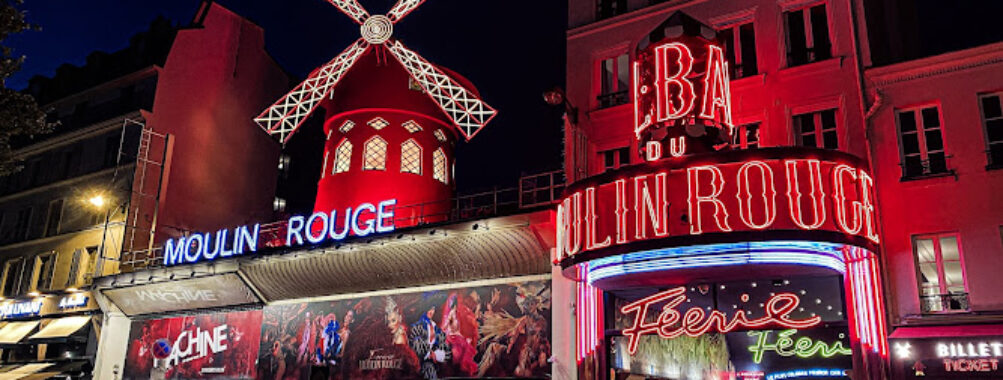
Moulin Rouge
“`html
Table of Contents
Description
The Moulin Rouge has this kind of magic that’s hard to explain until you’ve actually been there. It’s not just a cabaret—it’s a living, breathing piece of Parisian history that somehow still feels fresh every night. Established back in the late 19th century, it’s the birthplace of the can-can dance, and that energy still pulses through the red windmill that crowns the building. The Belle Époque decor is jaw-dropping—golden lights, red velvet drapes, and glittering chandeliers that make you feel like you’ve stepped into another century. I remember the first time I walked in; I half expected Toulouse-Lautrec himself to be sketching in the corner.
The atmosphere is unapologetically grand. It’s the kind of place where sequins and champagne flow as easily as laughter. And while some visitors might say it’s a bit over-the-top or touristy, I think that’s part of its charm. It’s Paris showing off—and why shouldn’t it? The dancers are world-class, the costumes are dazzling, and the music has this timeless rhythm that sweeps you up before you even realize you’re smiling.
There’s a sense of nostalgia mixed with modern glamour here. The show, “Féerie,” combines cabaret tradition with contemporary flair—feathers, acrobatics, and a bit of cheeky humor. You can enjoy it over a multi-course dinner, accompanied by fine wine or champagne (because, honestly, what else would you drink in Paris?). The service is polished without being stiff, and there’s a certain warmth that makes even first-time guests feel like insiders.
Of course, it’s not for everyone. Some find the prices steep or the crowds overwhelming, and I get that. But if you go in with an open mind—and maybe a little sparkle in your soul—you’ll leave with a story worth telling. The Moulin Rouge isn’t just a show; it’s an experience, a love letter to art, music, and the human desire to be dazzled.
Key Features
- Authentic Belle Époque interior with ornate decor and rich red tones
- World-famous cabaret performances featuring the traditional French can-can
- Fine dining options with gourmet French cuisine and table service
- Extensive wine, champagne, and cocktail selection curated by expert sommeliers
- Live music and dance acts performed by internationally acclaimed artists
- Wheelchair-accessible entrances, seating, and restrooms
- Reservations required due to high demand—often booked weeks in advance
- Upscale yet lively atmosphere that attracts both locals and travelers
- Paid parking available nearby, though public transport is often easier
Best Time to Visit
If you’re planning to catch a show, the evening is obviously when the magic happens. The first performance usually starts around dinner time, and if you’re lucky enough to snag a reservation for the later show, you might find the crowd a bit more relaxed. Personally, I think autumn is the best season to go—Paris feels quieter, the air is crisp, and the post-show stroll through Montmartre feels cinematic.
Summer, on the other hand, can be crowded, and tickets sell out fast. Winter evenings have their charm too; there’s something about stepping out of the cold into that warm, glowing interior that feels almost decadent. Just remember to book early, no matter the season. The Moulin Rouge doesn’t do “last-minute.”
How to Get There
Getting to the Moulin Rouge is pretty straightforward. It’s located right in the Montmartre district, which means you’ll probably end up wandering through some of the most picturesque streets in Paris on your way there. The easiest route is by metro—hop off at the Blanche station, and you’ll see the red windmill almost immediately.
If you’re staying elsewhere in the city, taxis or ride-share services are convenient, though traffic can be unpredictable, especially around showtime. I once made the mistake of taking a taxi from the Left Bank during rush hour—it took forever, but at least the driver had a good playlist. Walking from nearby neighborhoods like Pigalle or Abbesses is also an option if you want to soak in the area’s bohemian vibe.
Tips for Visiting
Here’s the thing about the Moulin Rouge—it rewards a bit of planning. First off, book your tickets as early as you can. The shows sell out quickly, especially on weekends. If you’re going for the dinner-and-show combo, arrive at least 30 minutes early; the dining experience is part of the spectacle.
Dress smartly. You don’t need to wear a tuxedo, but casual attire doesn’t quite fit the mood. Think cocktail dresses, jackets, and maybe a touch of sparkle. The staff appreciate it, and honestly, you’ll feel more a part of the glamour.
Photography isn’t allowed during the performance, and that’s actually a blessing—you get to be fully present. I used to think I’d miss capturing the moment, but being there, watching the dancers move in perfect sync, you realize some memories are better kept in your mind than your phone.
If you’re on a budget, skip the dinner and go for the show-only ticket. You’ll still get the full spectacle without the extra cost. But if you can splurge, the dinner is worth it—the food is surprisingly good for a venue that’s primarily known for entertainment.
And one last tip: don’t rush off afterward. The area around the Moulin Rouge, especially late at night, has this quirky, electric energy. There are cozy bars and cafés nearby where you can unwind and relive the evening over a glass of wine. It’s one of those rare experiences where even the walk back feels like part of the show.
In the end, visiting the Moulin Rouge isn’t just about ticking off a tourist attraction—it’s about stepping into a piece of living history. It’s loud, it’s glamorous, it’s a little chaotic at times—but that’s exactly what makes it unforgettable.
“`
Location
Places to Stay Near Moulin Rouge
Find and Book a Tour
Explore More Travel Guides
No reviews found! Be the first to review!